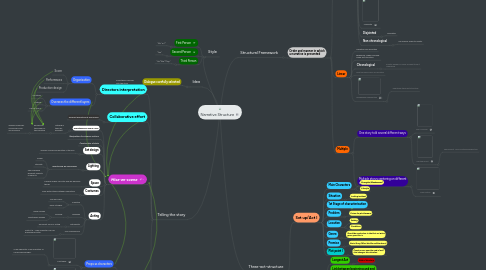
1. Style
1.1. First Person
1.1.1. "Me" or "I"
1.2. Second Person
1.2.1. "You"
1.3. Third Person
1.3.1. "He""She""They"
2. Idea
2.1. Dialogue carefully selected
2.1.1. Everything is woven into the story
3. Telling the story
3.1. Directors interpretation
3.1.1. Organisation
3.1.1.1. Score
3.1.1.2. Performaces
3.1.1.3. Production design
3.1.2. Oversees the different layers
3.1.2.1. Locations
3.1.2.2. Casting
3.1.2.3. Use of colour
3.2. Collaborative effort
3.2.1. Different departments and people
3.3. Mise-en-scene
3.3.1. Everything you see in a film
3.3.1.1. Nothing is there by accident
3.3.1.1.1. Enchances the power of the narrative
3.3.2. Manipulates the viewers emtions
3.3.3. Construction of shots
3.3.4. Set design
3.3.4.1. Amplify moods and emotion in the film
3.3.5. Lighting
3.3.5.1. Effects how we see images
3.3.5.1.1. Shade
3.3.5.1.2. Intensity
3.3.5.1.3. Can empahise different aspects of objects
3.3.6. Space
3.3.6.1. Camera angles can alter how we percieve things
3.3.7. Costumes
3.3.7.1. Clear distinctions between characters
3.3.8. Acting
3.3.8.1. Slapstick
3.3.8.1.1. Tom and Jerry
3.3.8.1.2. Three Stooges
3.3.8.2. Deadpan
3.3.8.2.1. Comedy
3.3.8.3. Naturalistic
3.3.8.3.1. Dominant form of acting
3.3.8.4. Non-Professional
3.3.8.4.1. District 9 - Lead character is a non professional actor
3.4. Characters
3.4.1. Props as characters
3.4.1.1. Cast away
3.4.1.1.1. A real character or an indication of a mans psychology?
3.4.1.2. Deul
3.4.2. Characterization
3.4.2.1. Personality
3.4.2.2. Appearance
3.4.2.3. Motivations
3.4.2.4. Beahviour
3.4.3. Protagonist
3.4.4. Tragic Hero
3.4.5. Antihero
3.4.6. Villain
3.4.7. False Protagonist
3.4.7.1. Character shield - main characters are protected by plot devices
4. Structural Framework
4.1. Order and manner in which a narrative is presented
4.1.1. Non Linear
4.1.1.1. Citizen Kane
4.1.1.2. Kill Bill
4.1.1.2.1. Acts are not in order
4.1.1.3. Tinker Tailor Soldier Spy
4.1.1.4. Momento
4.1.1.5. Disjointed
4.1.1.5.1. Disrupted
4.1.1.6. Non chronological
4.1.1.6.1. No specific order to events
4.1.2. Linear
4.1.2.1. Narrative runs smoothly
4.1.2.2. Beginning, Middle and End. Three-act-structure
4.1.2.3. Chronological
4.1.2.3.1. Events happen in order of what time it happened
4.1.2.4. Most common form of narrative
4.1.2.5. Shawshank Redemption
4.1.2.5.1. Traditional three act structure
4.1.3. Multiple
4.1.3.1. One story told several different ways
4.1.3.1.1. Run Lola Run
4.1.3.1.2. Vantage Point
4.1.3.2. Multiple storys centering on different characters
4.1.3.2.1. Pulp Fiction
5. Three-act-structure
5.1. Set up/Act I
5.1.1. Main Characters
5.1.1.1. Strengths/Weaknesses?
5.1.1.2. Lifestyle
5.1.2. Situation
5.1.2.1. Inciting incident
5.1.3. 1st Stage of characterisation
5.1.4. Problem
5.1.4.1. Drives the plot forward
5.1.5. Location
5.1.5.1. Setting
5.1.5.2. Conditions
5.1.6. Genre
5.1.6.1. Should be made clear in the first act what genre your film is
5.1.7. Premise
5.1.7.1. Basic Story (What the film will be about)
5.1.8. Plot point I
5.1.8.1. Event occurs near the end of act 1 that changes the situation
5.2. Conflict/Act II
5.2.1. Longest Act
5.2.1.1. Bulk of the story
5.2.2. Link between beginning and end
5.2.3. Turning point
5.2.3.1. Sharpens focus of the main character
5.2.4. Character development
5.2.5. Plot Point II
5.2.5.1. Crisis Point
5.2.5.1.1. Take action to resolve crisrs
5.2.5.1.2. Countdown/time running out
5.2.5.1.3. Character focuses on goal
5.3. Resolution/Act III
5.3.1. Greater Obstacles
5.3.1.1. Determined to overcome these obstacles to achieve goal
5.3.2. Confrontation
5.3.2.1. Problem is at a boiling point
5.3.3. Loose threads are tied up
5.3.4. Climax
5.3.4.1. Biggest scene
5.3.4.1.1. Main character saves the day
5.3.4.2. Dramatic
